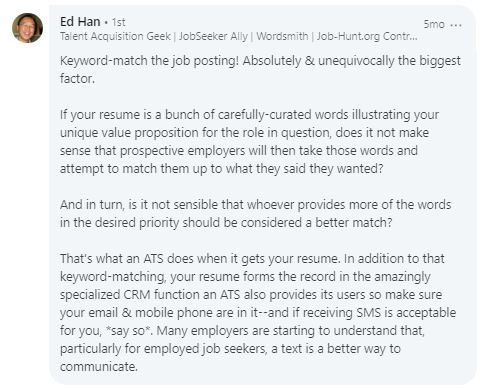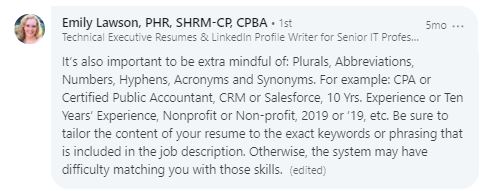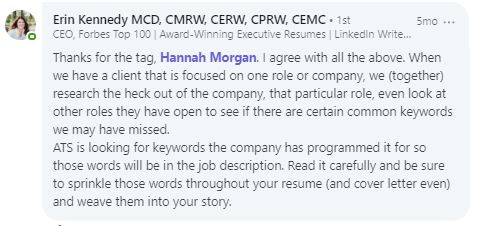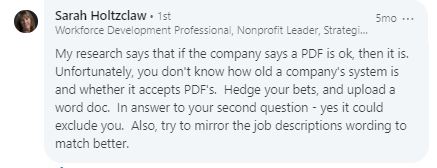Do you really understand how ATS work?
Here’s what you need to know about Applicant Tracking Systems (ATS) so that your resume actually gets seen by recruiters.
There is a lot of misunderstanding and misinformation about how ATS work.
Almost every company (large and small) uses this technology to help them store, process and evaluate candidates.
My hope is that by reading these comments, you will be better able to submit a keyword, ATS-friendly resume and your phone will start ringing.
This is the question I asked on LinkedIn and tagged some of my career colleagues to tap into their experiences and training on ATS.
In order to be successful landing interviews, job seekers need to understand how ATS work.
What is your best tip for helping applicants get past the robots reading their resume?
44,000 views later, this post has real gold in it.
But reading comments (especially when there are over 140 of them) gets difficult. And it’s nearly impossible to find this article after a couple of weeks. But here is the link.
How To Get Past The ATS
Here are the top 16 tips for getting past the ATS.
1. First, avoid the ATS
Many many career experts chimed in with the same advice- avoid the ATS!

Data shows that you only have a 2% chance on landing an interview when you apply online. On the other hand, referrals make up 40% of all hires (the largest channel by far).
I think 99% of job seekers would say that they don’t feel their resume accurately conveys their personality or their entire value.
Getting face to face with hiring managers allows you to do that and gives you the potential to land a referral (and avoid the online app completely).
Thank you Austin Belcak
And thank you Donna Svei, Executive Resume Writer

You are 10 times more likely to win the job by avoiding the ATS: Use This 10X Job Search Strategy https://buff.ly/2DFVuSi
2. The Bottom Line

Keyword-match the job posting! Absolutely & unequivocally the biggest factor. If your resume is a bunch of carefully-curated words illustrating your unique value proposition for the role in question, does it not make sense that prospective employers will then take those words and attempt to match them up to what they said they wanted?
And in turn, is it not sensible that whoever provides more of the words in the desired priority should be considered a better match? That’s what an ATS does when it gets your resume.
In addition to that keyword-matching, your resume forms the record in the amazingly specialized CRM function an ATS also provides its users so make sure your email & mobile phone are in it–and if receiving SMS is acceptable for you, *say so*.
Many employers are starting to understand that, particularly for employed job seekers, a text is a better way to communicate.
by Ed Han
3. Keep Formatting and Style Easy To Read (on phones)

No headers, no footers, no tables or templates. (Yeah I know that’s going to piss people off.) Simplify in a common font using simple bullets and spacing. I can’t believe how much crap opens weirdly, and my folks are techies! Send as pdf when you can but don’t use that as an excuse to over-format. MAKE IT EASY TO READ ON A PHONE.
by Linda Tuerk
4. Repeat- Do Not Put Info in Headers/Footers

I agree with the idea of BYPASSING wherever possible. If and when you have to apply online, for heavens sake don’t put your contact info in the header or footer — it will never get read!
by Virginia Franco, Executive Career Storyteller
5. Consider Plurals, Abbreviations, etc.

It’s also important to be extra mindful of: Plurals, Abbreviations, Numbers, Hyphens, Acronyms and Synonyms. For example: CPA or Certified Public Accountant, CRM or Salesforce, 10 Yrs. Experience or Ten Years’ Experience, Nonprofit or Non-profit, 2019 or ’19, etc. Be sure to tailor the content of your resume to the exact keywords or phrasing that is included in the job description. Otherwise, the system may have difficulty matching you with those skills.
by Emily Lawson, PHR, SHRM-CP, CPBA
6. But Don’t Make Your Resume Too Pretty

Be cautious of those “fancy” resume designs that don’t follow a traditional format or encourage you to embed images that contain valuable information. While these may look nice to the human eye, resumes with embedded images and unusual layouts often become a garbled mess, or get completely omitted from your application, after it passes through the applicant tracking system. I wrote an article with all my tips and an infographic on beating the dreaded hiring bots here.
7. What Are Keywords/Buzzwords?

The unfortunate reality is that recruiters in all fields are drawn to very specific buzzwords.
Silly example: if a job requirement is looking for experience with “aqua blue” but your resume shows experience with “Teal”, your resume/profile might not get noticed. An ATS is only going to pick up what a recruiter tells it to. Aqua Blue and Teal are pretty much the same, but the system doesn’t know that.
SO…as a candidate, if you know this, then make sure to pick up on the specific keywords used in the job description, and change your resume to show Aqua Blue instead of Teal so that you stand out.
PS – ESPECIALLY IN TECHNOLOGY, BE SPECIFIC WITH YOUR TOOLS & EXPERIENCES =)
Thank you Brian Reid
8. Titles Are Keywords

I echo what Ed Han said and would add a couple things: – Make sure the actual position title is in a prominent position on your resume. Normally this means at the very top of your resume.
– Use the exact keywords from the job posting as Ed already said. I would add to that to use complementary keywords. If there are other related keywords that are relevant to the position but not necessarily included in the posting make sure you use those throughout your resume too.
– You may not always know all the right keywords. Do research! Google the skills needed/expected for the position, industry and prospective employer. You could also use sites like Glassdoor or Indeed. But don’t be afraid of using a keyword research tool like Moz or SemRush to figure out what other words might be relevant.
It might be a little bit of research required on the front end but it will pay off in the long run with a shorter job search.
9. Match The Company

I agree with all the above. When we have a client that is focused on one role or company, we (together) research the heck out of the company, that particular role, even look at other roles they have open to see if there are certain common keywords we may have missed. ATS is looking for keywords the company has programmed it for so those words will be in the job description. Read it carefully and be sure to sprinkle those words throughout your resume (and cover letter even) and weave them into your story.
by Erin Kennedy MCD, CMRW, CERW, CPRW, CEMC
10. But Don’t Overdo It

I’ll add that it’s important to remember that after your resume gets screened by an ATS, a human also reviews it. It still needs to be visually appealing. I reviewed a resume recently with FIFTY “core competencies” bulleted out at the top. That’s overkill.
by Sarah Johnston, Job Search Expert
11. It’s Not A Buffet

…it is just really important for job seekers to move away from the “buffet style” style and treat every application by savoring every moment you have to customize every resume so it stands out as opposed to fitting in. I agree with Ed Han and Jessica Hernandez..keywords are very important and in line with what is being looked for. And, transfer that confidence-be compelling in terms of your accomplishment statements and share what will add to your career story…. not what is already “intuitively” recognized by employers/recruiters and often over-used with no real
12. Prepare An ATS Version

13. PDF or Word?

My research says that if the company says a PDF is ok, then it is. Unfortunately, you don’t know how old a company’s system is and whether it accepts PDF’s. Hedge your bets, and upload a word doc. In answer to your second question – yes it could exclude you. Also, try to mirror the job descriptions wording to match better.
14. If You Must Apply, Know This

If you absolutely can’t avoid the system then write your resume with the system top of mind. Identify meaningful keywords (both short and long-tail) and then think: repeatable and relevant when adding them to the file.
Next, demonstrate proficiency by sharing keywords in context and with a rich assortment of metrics. It is one thing to include a keyword and another thing entirely to provide proof of ability.
Finally, if you include content in the Header. Footer, Charts or Graphs – translate details into the body of the file so the system can find them. It is ok to house details in these areas/graphics but to be safe they should also appear in the body of the file.
by Adrienne Tom, Executive Resumes
15. Use Formatting To Your Advantage

1. Follow up in any way you can. Find the recruiter on LinkedIn, or, best case scenario, get someone you know there to fill out the referral paperwork.
2. Be more than keywords. Yes, you need them to get through, but everyone else who gets through will have them, too. Highlight your accomplishments and the experiences and qualifications that make you unique while adding value to the reader. ATS like keywords in context, so don’t waste space with long lists (great advice Sarah).
3. Stand out and increase readability. Don’t let ATS myths prevent you from creating a resume that uses formatting research shows increases consumption. Use it to highlight your differentiation. A human chooses who to interview!
16. Sure, People Still Get Hired Through ATS

I agree that referrals are much more effective, however you might not know someone at every company you wish to apply for. For example, I’ve gotten all of my positions (with the exception of my first job) by applying online via ATS. And I think it’s bad advice to tell people essentially that if they don’t know someone who can refer them, they should just not apply.
Tools & Tips To Help With Keywords & ATS
Jobscan.co was mentioned by a couple of people. Check it out.
TagCrowd.com was mentioned as another way to identify keywords in job postings.

Hannah Morgan speaks and writes about job search and career strategies. She founded CareerSherpa.net to educate professionals on how to maneuver through today’s job search process. Hannah was nominated as a LinkedIn Top Voice in Job Search and Careers and is a regular contributor to US News & World Report. She has been quoted by media outlets, including Forbes, USA Today, Money Magazine, Huffington Post, as well as many other publications. She is also author of The Infographic Resume and co-author of Social Networking for Business Success.

